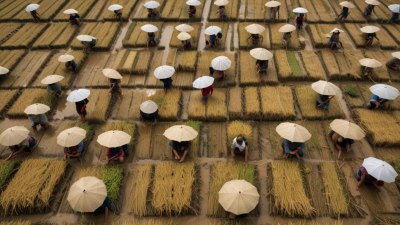Why Asia’s Climate Is as Diverse as Its Food - And Just as Intense
Explore the diverse climates of Asia and how they compare to the continent's rich culinary heritage.

This image was created with the assistance of Freepik
Asia, the largest and most populous continent, is a canvas painted with a myriad of climates, each as diverse and vibrant as its rich culinary traditions. From the icy mountains of the Himalayas to the tropical shores of Southeast Asia, the continent's climate is shaped by geographical features and atmospheric patterns, creating an array of environments that foster unique food cultures. This article delves into the climatic diversity of Asia and draws parallels between its weather systems and the culinary practices that have evolved in response to these conditions.
To comprehend the climatic diversity in Asia, we start with its geographical layout. The continent is home to vast mountain ranges, extensive deserts, rolling plains, and numerous water bodies. The Himalayas, the highest mountain range globally, not only influence the weather patterns in South Asia but also create some of the most extreme climates on the planet. The elevation leads to diverse ecological zones, where one can find everything from temperate forests to alpine tundra. Each zone supports distinct flora and fauna that have been intricately woven into local cuisines, enriching them with unique flavors and ingredients.
Southeast Asia, on the other hand, is characterized by a tropical rainforest climate, with high humidity and abundant rainfall. Countries like Thailand, Vietnam, and Indonesia showcase vibrant culinary practices that revolve around the fresh produce of their lush environments. Rice and spices, which are staples in these cuisines, flourish in the humid climate, while the resulting dishes are often spicy, aromatic, and colorful – much like the region's biodiversity.
Monsoon and Its Culinary Effects
The monsoon season, a significant climatic phenomenon in Asia, primarily affects countries in South and Southeast Asia. The seasonal winds bring heavy rains that are crucial for agriculture. The impact of the monsoon on food is profound; it determines what can be cultivated, thus influencing dietary staples. For instance, during the monsoon months, the production of rice surges, which results in an abundance of rice-based dishes. In India, for example, khichdi, a comforting porridge of rice and lentils, becomes a common meal, celebrated for its warmth and nutritional value during the rainy season.
Moreover, the relationship between climate and food does not stop at agriculture. The monsoon rains create a thriving environment for various seafood, particularly in coastal areas. Fish plays a crucial role in diets, with many indigenous recipes showcasing techniques like smoking or drying to preserve the catch during bounteous seasons. The culinary heritage reflects the monsoon's rhythm, celebrating the arrival of rains and the bounty it brings.
Arid Climates and Resourcefulness
Contrasting with the monsoon-drenched regions, the arid climates of Central Asia and parts of West Asia present unique challenges. Here, limited water resources shape the landscape and, consequently, culinary practices. Countries like Kazakhstan and Iran adopt resourceful cooking methods, such as slow cooking and preservation techniques, to make the most of what is available. Dishes like pilaf or kebabs are not just culinary delights; they symbolize a culture of adaptation to environmental constraints.
Dried fruits, fermented dairy products, and hearty grains form the basis of many traditional meals. The diversity in climate directly informs how people prepare and consume their food, showcasing their ingenuity in utilizing local ingredients. This resourcefulness transcends geographical boundaries, uniting many Asian cultures in a shared narrative of resilience.
Polar Regions and Indigenous Cuisines
In the northernmost parts of Asia, particularly in regions like Siberia, the climate becomes severe and inhospitable during long winters. Indigenous populations, such as the Yakuts and Sámi, have developed unique culinary traditions adapted to their environment. The use of preserved and fermented foods is prominent, employing techniques that harness the freezing temperatures to store food safely. Dishes made from reindeer, fish, and foraged plants showcase this adaptation and highlight the connection between struggling against harsh climates and culinary innovation.
In these regions, meals are often communal, emphasizing social bonding and cultural preservation amid challenging conditions. The intensity of the climate teaches lessons on sustainability and mindfulness in food consumption, resonating deeply in the traditional diets of the people. Each bite tells a story of survival, adaptation, and cultural pride, mirroring the very landscapes they inhabit.
Urbanization and Changing Climates
As Asia undergoes rapid urbanization, the implications of climate change are becoming increasingly evident. Coastal cities like Bangkok, Mumbai, and Jakarta face rising sea levels and intensified weather patterns, impacting traditional food sources and supply chains. Urban culinary landscapes are expanding to incorporate global influences, resulting in a fusion of flavors but often at the expense of local ingredients.
However, these changes also present opportunities for innovation. Urban chefs are increasingly focused on sustainability, utilizing local, seasonal ingredients in their dishes to combat the damaging effects of climate change on traditional agriculture. The emergence of farm-to-table movements in metropolitan areas heralds a new way of engaging with food, emphasizing the need to respect and reflect the diverse climates that yield them.
Climate Diversity Reflecting Food Diversity
Asia's climate indeed plays a crucial role in shaping its varied culinary practices. The richness of flavors, cooking techniques, and food traditions can be traced back to the environmental conditions of each region. Whether it is the heat of spices in Indian curries or the freshness of ingredients in Japanese sushi, the climate informs not only what is available but also how it is cherished and prepared.
Understanding these connections provides a deeper appreciation for the culinary experiences that Asia has to offer. From the intricate balance of spices in centennial recipes to the emphasis on local foods in urban gastronomy, each dish serves as a unique narrative reflecting its environmental context. The dance between climate and cuisine is a testament to human creativity and resilience, showcasing a rich diversity that is as intense as it is delightful.
The Future of Culinary Diversity
As the world becomes increasingly aware of climate change and its impacts, the future of Asian cuisine will undoubtedly evolve. The challenges that shifting weather patterns bring to agricultural practices will force chefs and home cooks alike to rethink how they source their ingredients. There is a growing trend towards using indigenous ingredients and reviving forgotten culinary methods that align with sustainable practices.
In various Asian countries, movements to preserve traditional foods and practices gain momentum. As communities work towards maintaining their cultural heritage, the importance of biodiversity in both climate and cuisine becomes apparent. The future of food is likely to be one that appreciates the importance of local climates, respects sustainable practices, and embraces the diverse culinary heritage that Asia has to offer.
In conclusion, the climates of Asia not only shape the landscapes and ecosystems but also define the culinary narratives that emerge from them. The interplay between geography and cuisine reveals a tapestry of flavors and traditions, making Asia a true gastronomic paradise. As we confront the challenges ahead, understanding and celebrating this diversity will be critical, ensuring that our culinary heritage continues to thrive in harmony with our ever-changing climates.











